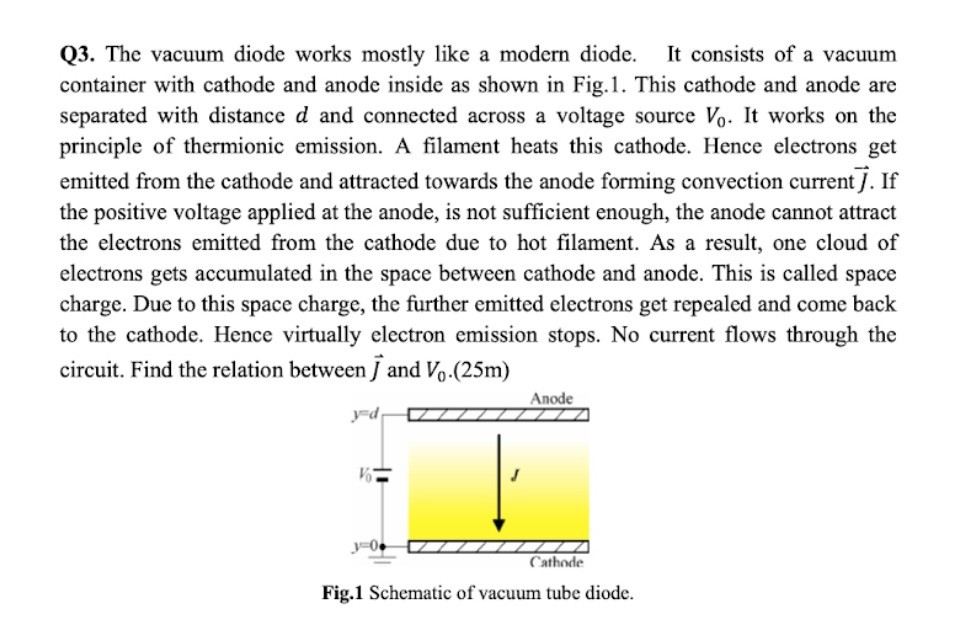It consists of a vacuum Q3. The vacuum diode works mostly like a modern diode. container with cathode and anode inside as shown in Fig.1. This cathode and anode are separated with distance d and connected across a voltage source Vo. It works on the principle of thermionic emission. A filament heats this cathode. Hence electrons get emitted from the cathode and attracted towards the anode forming convection current J. If the positive voltage applied at the anode, is not sufficient enough, the anode cannot attract the electrons emitted from the cathode due to hot filament. As a result, one cloud of electrons gets accumulated in the space between cathode and anode. This is called space charge. Due to this space charge, the further emitted electrons get repealed and come back to the cathode. Hence virtually electron emission stops. No current flows through the circuit. Find the relation between J and Vo.(25m)
It consists of a vacuum Q3. The vacuum diode works mostly like a modern diode. container with cathode and anode inside as shown in Fig.1. This cathode and anode are separated with distance d and connected across a voltage source Vo. It works on the principle of thermionic emission. A filament heats this cathode. Hence electrons get emitted from the cathode and attracted towards the anode forming convection current J. If the positive voltage applied at the anode, is not sufficient enough, the anode cannot attract the electrons emitted from the cathode due to hot filament. As a result, one cloud of electrons gets accumulated in the space between cathode and anode. This is called space charge. Due to this space charge, the further emitted electrons get repealed and come back to the cathode. Hence virtually electron emission stops. No current flows through the circuit. Find the relation between J and Vo.(25m)
Introductory Circuit Analysis (13th Edition)
13th Edition
ISBN:9780133923605
Author:Robert L. Boylestad
Publisher:Robert L. Boylestad
Chapter1: Introduction
Section: Chapter Questions
Problem 1P: Visit your local library (at school or home) and describe the extent to which it provides literature...
Related questions
Question

Transcribed Image Text:It consists of a vacuum
Q3. The vacuum diode works mostly like a modern diode.
container with cathode and anode inside as shown in Fig.1. This cathode and anode are
separated with distance d and connected across a voltage source Vo. It works on the
principle of thermionic emission. A filament heats this cathode. Hence electrons get
emitted from the cathode and attracted towards the anode forming convection current J. If
the positive voltage applied at the anode, is not sufficient enough, the anode cannot attract
the electrons emitted from the cathode due to hot filament. As a result, one cloud of
electrons gets accumulated in the space between cathode and anode. This is called space
charge. Due to this space charge, the further emitted electrons get repealed and come back
to the cathode. Hence virtually electron emission stops. No current flows through the
circuit. Find the relation between J and Vo.(25m)
Expert Solution
This question has been solved!
Explore an expertly crafted, step-by-step solution for a thorough understanding of key concepts.
This is a popular solution!
Trending now
This is a popular solution!
Step by step
Solved in 3 steps with 3 images

Knowledge Booster
Learn more about
Need a deep-dive on the concept behind this application? Look no further. Learn more about this topic, electrical-engineering and related others by exploring similar questions and additional content below.Recommended textbooks for you

Introductory Circuit Analysis (13th Edition)
Electrical Engineering
ISBN:
9780133923605
Author:
Robert L. Boylestad
Publisher:
PEARSON

Delmar's Standard Textbook Of Electricity
Electrical Engineering
ISBN:
9781337900348
Author:
Stephen L. Herman
Publisher:
Cengage Learning

Programmable Logic Controllers
Electrical Engineering
ISBN:
9780073373843
Author:
Frank D. Petruzella
Publisher:
McGraw-Hill Education

Introductory Circuit Analysis (13th Edition)
Electrical Engineering
ISBN:
9780133923605
Author:
Robert L. Boylestad
Publisher:
PEARSON

Delmar's Standard Textbook Of Electricity
Electrical Engineering
ISBN:
9781337900348
Author:
Stephen L. Herman
Publisher:
Cengage Learning

Programmable Logic Controllers
Electrical Engineering
ISBN:
9780073373843
Author:
Frank D. Petruzella
Publisher:
McGraw-Hill Education

Fundamentals of Electric Circuits
Electrical Engineering
ISBN:
9780078028229
Author:
Charles K Alexander, Matthew Sadiku
Publisher:
McGraw-Hill Education

Electric Circuits. (11th Edition)
Electrical Engineering
ISBN:
9780134746968
Author:
James W. Nilsson, Susan Riedel
Publisher:
PEARSON

Engineering Electromagnetics
Electrical Engineering
ISBN:
9780078028151
Author:
Hayt, William H. (william Hart), Jr, BUCK, John A.
Publisher:
Mcgraw-hill Education,